
The Missouri Botanical Garden is a botanical garden located at 4344 Shaw Boulevard in St. Louis, Missouri. It is also known informally as Shaw's Garden for founder and philanthropist Henry Shaw. Its herbarium, with more than 6.6 million specimens, is the second largest in North America, behind only that of the New York Botanical Garden.

Boswellia is a genus of trees in the order Sapindales, known for their fragrant resin. The biblical incense frankincense was an extract from the resin of the tree Boswellia sacra, and is now produced also from B. frereana.
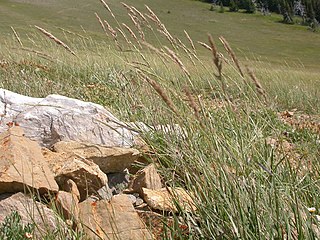
Calamagrostis purpurascens, variously known by the common names purple reedgrass, purple pinegrass, or alpine reedgrass is a perennial grass, growing 30 to 70 centimetres (28 in) tall.

Juniperus procera is a coniferous tree native to mountainous areas in Africa and the Arabian Peninsula. It is a characteristic tree of the Afromontane flora.
Magnolia wolfii is a tree species in the Magnoliaceae family. It is endemic to Colombia. The species is recorded only from one locality in Risaralda Department. The species is being investigated by a conservation and propagation research program implemented by the Technological University of Pereira, with the support of Botanic Gardens Conservation International.
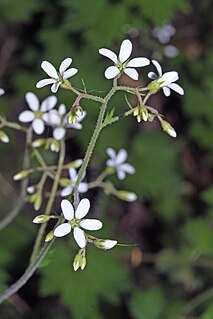
Boykinia is a small genus of plants related to the saxifrages. It contains at least nine species, known as brookfoams. Brookfoams are glandular rhizomatous creeping perennials with highly lobed or toothed leaves and inflorescences of petite flowers. They are native to North America and Asia.
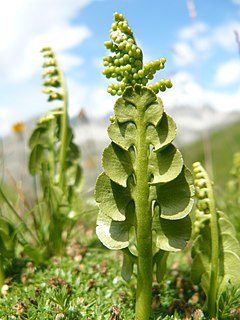
Botrychium lunaria is a species of fern in the family Ophioglossaceae known by the common name moonwort or common moonwort. It is the most widely distributed moonwort, growing throughout the Northern Hemisphere across Eurasia and from Alaska to Greenland, as well as temperate parts of the Southern Hemisphere.
Paul Hamilton Allen (1911–1963) was an American botanist noted for his work on the ecology of Central America, orchid systematics and economically important species including bananas. He was married to the former Dorothy Osdieck of Kirkwood, Missouri.
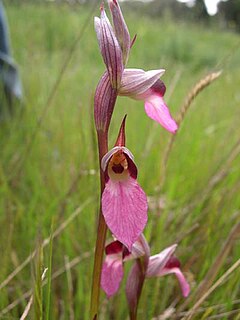
Serapias lingua, commonly known as tongue-orchid or the tongue Serapias, is a species of orchid native to the Mediterranean.
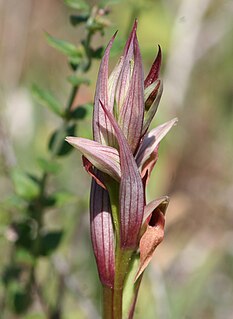
Serapias parviflora, the small-flowered tongue-orchid, is a species of orchid native to the Mediterranean Basin and the Atlantic coast of Europe.
Carlyle A. Luer is a botanist specializing in the Orchidaceae. His specialty interest is the Pleurothallidinae and allied species.
Monelytrum is a monotypic genus of grass in the Poaceae family. Its sole species, Monelytrum luederitzianum is endemic to Namibia. Both common and scientific names were named for the city of Lüderitz, located in the far south of Namibia.
Vitis bryoniifolia is a prolific and adaptable, polygamo-dioecious species of climbing vine in the grape family native to China, where it is known as ying yu, or hua bei pu tao. The variant form ternata is known as san chu ying yu, meaning three-foliolate, or -leaflet ying yu. Ying yu translates to mean "hard jade".

Dysoxylum rufum is a rainforest tree in the Mahogany family, found in eastern Australia. It occurs on a variety of different soils and rainforest types. From as far south as Bulahdelah, New South Wales to the McIlwraith Range in far north eastern Australia. The specific epithet rufum refers to the rusty red of the leaf, fruit and flower hairs of this species.

Selaginella cinerascens is a species of spikemoss known by the common names mesa spikemoss, gray spikemoss, and ashy spikemoss. It is native to Baja California as well as some locations just north of the border in San Diego County, California. It grows in dry habitat, often on clay soil, both in open areas and in the shade of larger plants. This lycophyte forms mats of spreading, forking stems up to 18 centimeters long. The plant is often gray or brown in color, forming a dull-colored carpet on the substrate. The linear or lance-shaped leaves are 1 to 3 millimeters long and lack bristles at the tips. The leaves are green when new or moist. They are flattened to the stem or stick out just a little. The strobili borne at the leaf bases are yellow in color and no more than 4 to 5 millimeters long.
Serapias stenopetala is an Orchid plant that is in the genus Serapias. The common name of the plant is sérapias à pétales étroits in French. The plant is endemic to Algeria, and Tunisia.
Lonchitis is a neotropical genus of ferns. It is the sole genus in the family Lonchitidaceae. At one time Lonchitis was placed in the Dennstaedtiaceae, and then transferred to the Lindsaeaceae, before being placed in its own family.
Poa poiformis, commonly known as coast tussock-grass or blue tussock-grass, is a densely tufted, erect, perennial tussock grass, with distinctive blue-green leaves, that grows to about 1 m in height. Its inflorescences are arranged in a dense panicle up to 30 cm long. It is native to coastal southern Australia where it occurs along ocean foreshores, estuaries, dunes and cliffs. P. poiformis is also found on Kangaroo Island and Lord Howe Island.

Allium libani is a species of wild bulbous plant geophyte of the genus Allium, belonging to the family of Amaryllidaceae. Allium libani is endemic to the Middle East in Lebanon and Syria.

Hippeastrum striatum a flowering perennial herbaceous bulbous plant, in the Amaryllidaceae family, native to the southern and eastern regions of Brazil.















